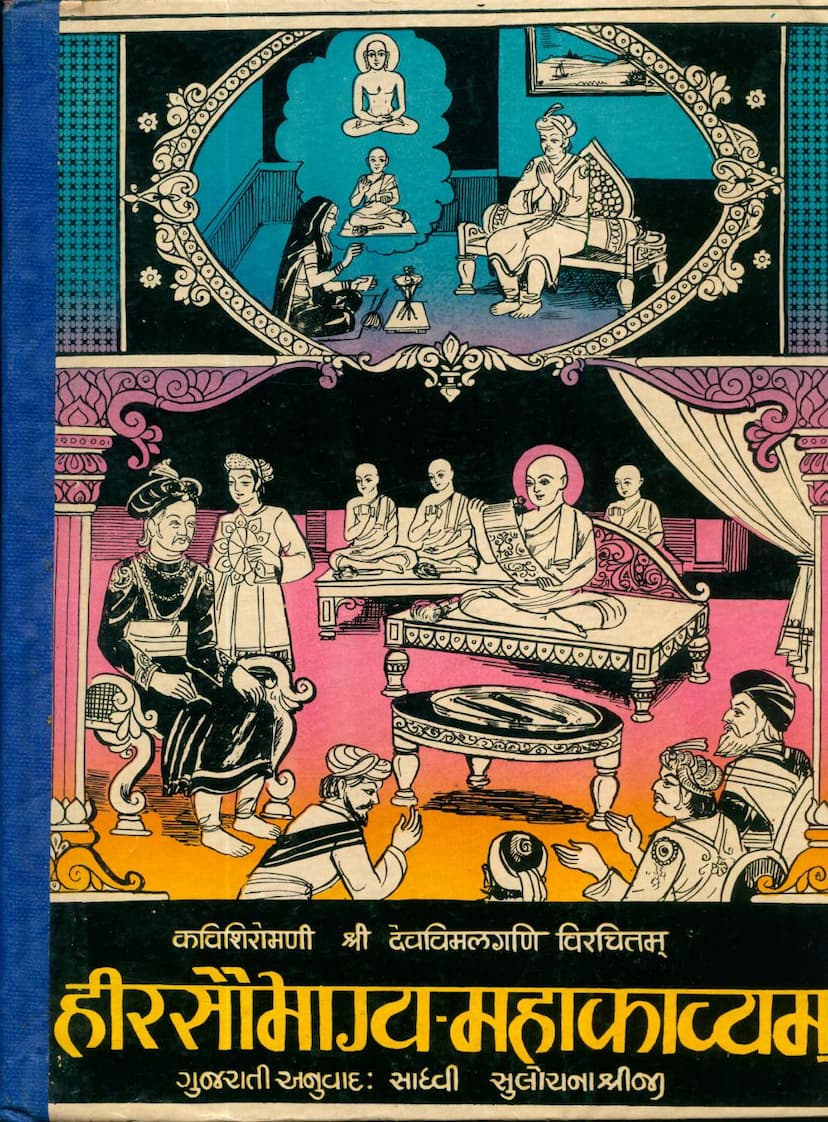Heersaubhagya Mahakavyam Part 02
Added to library: September 1, 2025

Summary
This is a comprehensive summary of the Jain text "Heersaubhagya Mahakavyam Part 02," based on the provided text and catalog link.
Book Title: Heersaubhagya Mahakavyam Part 02 Author(s): Devvimal Gani, Sulochanashreeji Publisher: Kantilal Chimanlal Shah Catalog Link: https://jainqq.org/explore/005968/1
Overview:
"Heersaubhagya Mahakavyam Part 02" is the second volume of a significant Jain epic poem, "Heersaubhagya Mahakavyam," originally authored by Devvimal Gani and translated into Gujarati by Sadhvi Sulochana Shreeji. This volume covers cantos 9 through 13 of the epic. The work is a biographical narrative, likely focusing on the life and deeds of a prominent Jain Acharya, possibly Heeravijaya Suri, given the title. The text provides a detailed account of religious journeys, philosophical discourses, and significant events, interwoven with rich poetic descriptions and devotional elements characteristic of Mahakavyas.
Content Summary (Cantos 9-13):
The provided text consists of the Gujarati translation and commentary on Cantos 9 to 13 of the "Heersaubhagya Mahakavyam." Based on the detailed table of contents and verse-by-verse summaries, these cantos cover a substantial portion of the narrative, likely detailing important events in the life of the protagonist, Acharya Heeravijaya Suri, and his interactions with royalty and the Jain sangha.
Key Themes and Events (Indicative from Cantos 9-13):
- Shasan Devi's Divine Intervention and Guidance (Canto 9): The Shasan Devi (guardian deity of the Jain faith) appears to the Acharya, questions him, and reaffirms his divine mission. This section highlights the divine support and guidance available to great spiritual leaders in Jainism.
- Acharya's Travels and Teachings: The cantos likely describe the Acharya's extensive travels across various regions (e.g., mentioning places like Ahmedabad, Delhi, Gandhar, and Fatehpur). During these journeys, he engages in spiritual discourses, imparts teachings, and likely performs miracles or demonstrates spiritual powers.
- Interactions with Royalty and Patrons: A significant portion of the narrative involves the Acharya's interactions with rulers and influential figures, notably Emperor Akbar. The text details the events leading to Akbar's invitation to the Acharya, their meetings, and likely the philosophical discussions that influenced the Emperor. The support and patronage of royal figures are often depicted to highlight the influence and respect the Acharya commanded.
- Establishment of Jain Principles and Institutions: The cantos might detail the establishment or reinforcement of Jain principles, the propagation of right faith (Samyak Darshan), and potentially the founding of temples or institutions, reflecting the Acharya's mission to spread Jainism.
- Spiritual Discourses and Miracles: Jain Mahakavyas often include descriptions of the Acharya's profound knowledge, his ability to debate scholars of other faiths, and the miracles he performed to demonstrate the power of Jain principles.
- The Role of Disciples and the Sangha: The text likely portrays the devoted disciples and the broader Jain community (Sangha) supporting the Acharya's mission and participating in religious ceremonies.
- Natural Beauty and Devotional Descriptions: Poetic descriptions of natural scenery, dawn, sunrise, and the divine presence are expected to be present, enhancing the devotional and aesthetic appeal of the work.
- Specific Events:
- Canto 9: The Shasan Devi's appearance, Acharya's discussion with the deity, his travels, and entry into Ahmedabad, including significant religious ceremonies.
- Canto 10: Likely covers the Acharya's journey to Delhi and interactions with Emperor Akbar, possibly including discussions on religious tolerance and Jain philosophy, and the events at Fatehpur.
- Canto 11: Continues the narrative of interactions with royalty, perhaps the Acharya's return journey or further engagements with the Emperor. It also includes discussions on the contributions of patrons and the success of the mission.
- Canto 12: Details the Acharya's travels to various locations like Gandhar and Abu (Arbudachal), highlighting his spiritual influence and interactions with local communities and rulers. The canto likely concludes with his return or onward journey.
- Canto 13: Continues the travels, potentially including the Acharya's presence in Sirohi (Shiva-puri) and the significant events that transpired there, culminating in his return journey or continued propagation of Jainism.
Significance:
"Heersaubhagya Mahakavyam" is a vital text for understanding the historical and spiritual context of Jainism, particularly during the period of great Acharyas. It serves not only as a religious scripture but also as a literary masterpiece, preserving cultural and philosophical insights. The Gujarati translation makes this profound work accessible to a wider audience, facilitating the spread of Jain teachings and heritage. The inclusion of commentary (indicated by "par tikar sahit") further enhances its value by clarifying the verses and providing deeper insights into the text's meaning. The publisher's details and the publication date (VS 2033) suggest it's a well-researched and carefully presented edition.
This summary is based on the structural information and thematic elements evident from the provided text snippets and the catalog entry. A deeper understanding would require a full reading of the text itself.